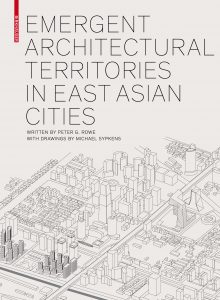Emergent Architectural Territories in East Asian Cities
 Beginning around the 1990s in East Asian cities various concatenations of events led those in power, along with many segments of society, to turn away from production-oriented and narrowly-defined pathways forward in modernization towards a much fuller embrace of broader lifestyle opportunities, improved environmental amenities, and higher standards of urban living. As a consequence, a paradigm shift in attitudes and orientations began to occur, becoming materially obvious certainly during the first decade of the new millennium. In effect, what transpired were ‘turning’ or ‘tipping points’ in the dynamics of urban change. They did not happen all at once, neither were they occasioned by the same factors and influences, nor were they otherwise aligned symmetrically. However, in a generalized manner most places were making a transition from ‘development states’ into ‘competition states’. Urbanistically many major cities in the region were also changing from modern into post-modern entities from a functional perspective, which in itself was part of the same dynamic.
Beginning around the 1990s in East Asian cities various concatenations of events led those in power, along with many segments of society, to turn away from production-oriented and narrowly-defined pathways forward in modernization towards a much fuller embrace of broader lifestyle opportunities, improved environmental amenities, and higher standards of urban living. As a consequence, a paradigm shift in attitudes and orientations began to occur, becoming materially obvious certainly during the first decade of the new millennium. In effect, what transpired were ‘turning’ or ‘tipping points’ in the dynamics of urban change. They did not happen all at once, neither were they occasioned by the same factors and influences, nor were they otherwise aligned symmetrically. However, in a generalized manner most places were making a transition from ‘development states’ into ‘competition states’. Urbanistically many major cities in the region were also changing from modern into post-modern entities from a functional perspective, which in itself was part of the same dynamic.
Within the scope of these turning points, new territories were chartered and new forms of urban-architectural development and expression were engaged in. Indeed, this book, as its title suggests, is organized primarily around the conceptual framework of architectural territories and their geographies occasioned by these breaks with the past. Within this framework ‘territory’ refers to both a tract of land and to a sphere, or field, of action. In keeping with its common definition, ‘geography’ refers to differentiation within a territory, accomplished with respect to characteristics of and interrelationships among physical features. This differentiation, in turn, applies to a territory in both senses and also brings along a particular geography (i.e. what was actually built) and an intrinsic geography in the sense of a collection of different building forms or typologies comprising a known or soon to be known universe of particular manners or kinds of buildings (i.e. a range of possible construals and architectural accomplishments).
The chapters which follow are organized according to territorial considerations either involving specific tracts of relevance embracing several spheres of action, or various tracts and projects that coalesce around important spheres of action. Each chapter then concentrates on specific architectural projects within a particular territory, sorting through the actual projects in relationship to their architectural geographies and situational logics. In addition, other relevant or significant projects not yet constructed within a territory or built elsewhere, are briefly discussed where necessary, in order to round out the overall presentation.
With drawings by Michael Sypkens
Birkhäuser